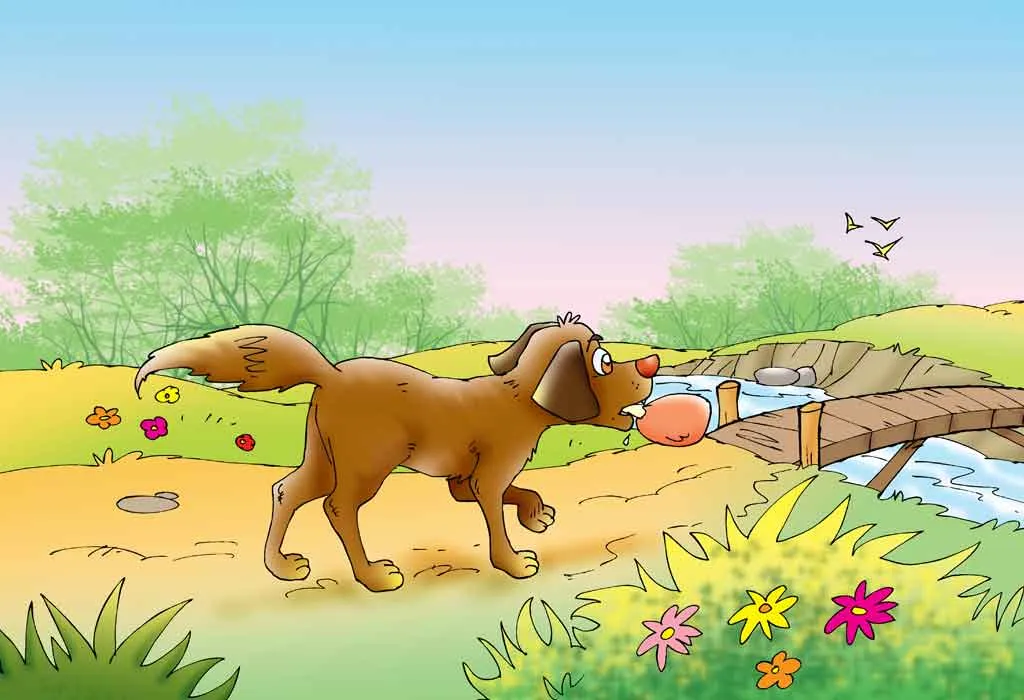Stories possess a magical ability to transport young minds to wondrous new realms. Sharing a story with a child ignites their imagination, allowing them to connect with characters they might otherwise never encounter. Beyond merely describing the world around them, stories are potent tools for fostering curiosity, expanding vocabulary, and providing an avenue for expression. Bedtime tales, in particular, often feature relatable characters that inspire children, strengthen the parent-child bond, alleviate stress, reinforce literacy, and enhance language proficiency. Among these, “The Greedy Dog” stands out as a classic moral story, effectively illustrating the detrimental consequences of greed.
ADVERTISEMENTS
The Enduring Legacy of “The Greedy Dog”
The origins of “The Greedy Dog” story can be traced back to ancient Persia. Scholarly research suggests its inclusion in a collection of tales compiled by Abdul Fazl, a trusted advisor to Emperor Akbar. This narrative also finds a parallel in Aesop’s Fables, consistently highlighting greed as a source of misfortune.
ADVERTISEMENTS
Understanding the Narrative of “The Greedy Dog”
“The Greedy Dog” can be categorized as both a bedtime story and a moral tale. Its central message underscores the self-inflicted harm that excessive greed can cause, while also emphasizing the importance of prudence during scarcity.
ADVERTISEMENTS
The Characters of the Tale
The narrative primarily centers on a dog, whose inherent traits and experiences drive the plot. This canine protagonist serves as the pivotal figure, conveying the story’s core values to young audiences.
ADVERTISEMENTS
The Story of the Greedy Dog
In a humble village, there lived a dog perpetually seeking sustenance. This dog was not only always hungry but also deeply greedy, never content with what he possessed. He roamed far and wide in his endless search for food, never finding satisfaction. Each time he acquired a morsel, he’d vow to be content, only to forget his promise moments later, driven by an insatiable desire for more.
 A dog looking at its reflection in water with a bone in its mouth
A dog looking at its reflection in water with a bone in its mouth
One day, his usual quest led him near a flowing river. A bridge spanned the water, offering passage to the other side. Deciding to explore, he set off in search of food. His initial search proved fruitless. Then, he spotted a bone outside a small dwelling. It was a large, succulent bone, and he seized it with determination. He planned to cross the bridge and savor his prize at home, fearing that any acquaintances or other animals might discover his find and demand a share. He yearned to enjoy it all by himself.
ADVERTISEMENTS
As he traversed the bridge, he noticed another dog on the opposite side, also holding a bone. This bone appeared as large and tempting as his own. A surge of desire washed over him; he imagined the joy of possessing both bones. He began to concoct a plan to acquire the other dog’s bone. With a defiant bark, he intended to startle the other dog into dropping its prize. The instant he barked, however, the bone he was carrying slipped from his jaws and plunged into the water. In his shock, he too lost his footing and tumbled into the river. He was swept downstream until he managed to clamber onto dry land. It was then that the stark realization dawned upon him: the other dog was merely his own reflection in the water. He was filled with profound regret, understanding the foolishness of his greed. He had to return home empty-pawed and hungry, having paid a heavy price for his avarice. This experience served as a harsh lesson, and he vowed to abandon his greedy ways.
A Concise Recap of the Tale
The essence of “The Greedy Dog” story is straightforward: greed often leads to foolish actions, resulting in the loss of what one already possesses. The dog in the narrative, consumed by greed, encountered a tempting bone near a bridge. While crossing, he mistook his own reflection for another dog with a similar bone. His attempt to scare away this perceived rival led to him dropping his own bone into the river. Consequently, his greed left him with nothing.
ADVERTISEMENTS
The Profound Moral of the Story
The central moral of this story is a powerful reminder: “We should not be greedy.” Greed is a destructive force, compelling individuals to make poor choices. It fosters selfishness, short temper, anxiety, and envy. Embracing greed blinds one to the true value of possessions and hinders the ability to face challenges and opportunities with courage and wisdom. It is far more beneficial to work diligently for what one desires and to be content with what one has, rather than coveting the belongings of others.
Applying the Moral in Everyday Life
“The Greedy Dog” offers invaluable lessons for children. Young children, often easily tempted, may not grasp the concept of limited resources, leading to tantrums and aggressive behavior. This story vividly illustrates how the dog’s efforts to secure food were ultimately undone by his succumbing to temptation. Children frequently desire what their siblings or friends possess, prompting insistent demands from parents. However, this tale teaches the crucial importance of contentment and the virtue of earning what one wants.
ADVERTISEMENTS
Moral-driven bedtime stories are an excellent method for instilling good habits in children. They play a vital role in nurturing their personalities, shaping them into individuals of strong character. These narratives lay the foundation for a child’s development, leaving a lasting impression on peers and adults alike.
